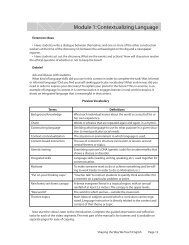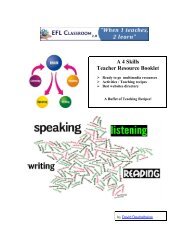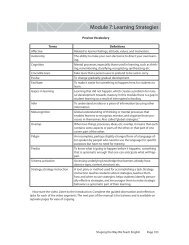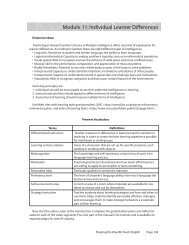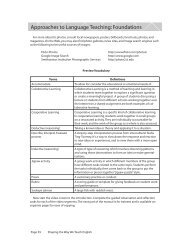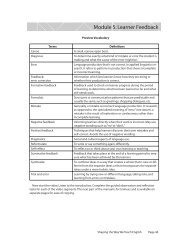Ten Audience Analysis Exercises - EFL Classroom 2.0
Ten Audience Analysis Exercises - EFL Classroom 2.0
Ten Audience Analysis Exercises - EFL Classroom 2.0
Create successful ePaper yourself
Turn your PDF publications into a flip-book with our unique Google optimized e-Paper software.
<strong>Ten</strong> Ways to Ask Students to Re-think the <strong>Classroom</strong><br />
1. Place your students in the future. It's the year 3098. A team of archaeologists<br />
discovers your classroom, exactly as it is now. What do they make of their<br />
discovery? How do they describe the space? What do they imagine happened in<br />
the place? How do they support their findings--that is, what things in the space<br />
support their conclusions? Students could form teams (writing groups) and work<br />
in online InterChange conferences to gather ideas about the space. They might<br />
write a group paper or individual papers reporting their findings to the<br />
organization that funded their archeological dig. Or they could write a "newspaper<br />
article" (whatever the equivalent to a "newspaper article" is in 3098). You might<br />
even ask them to write about their discovery as an email message to a friend or<br />
family member.<br />
2. Ask your students to work as ethnographers in the classroom--explain the idea of<br />
participant-observers, and have your students observe the community in your<br />
classroom. What social structures exist? How do members of the community<br />
interact? How do the physical structures in the classroom affect the community?<br />
By comparison, you might ask students to observe the ways that computers work<br />
in other places on your campus--what kind of community is built (or not) in<br />
public access computer labs, around workstations in the library, and so forth.<br />
Students might examine the differences: how does the community change, and<br />
why does it change?<br />
3. Make your students classroom designers. Give them carte blanche to rethink the<br />
set-up and layout of the room--move the desks, tables, machines, and so forth.<br />
Add equipment, furniture, and/or resources. If you have a drawing program on<br />
your computers, they might even sketch out their designs. After their rethinking,<br />
have students write a proposal to implement their changes--ask them to include an<br />
explanation of the changes they would make AND a detailed justification for the<br />
changes. For example, saying that they want to add a conference table to the room<br />
isn't enough--ask them to explain why the conference table should be added and<br />
how it will affect the learning that takes place in the space.<br />
4. Enter an online discussion on the advantages and disadvantages of the computerbased<br />
classroom. Ask students to use pseudonyms--Your discussion should<br />
include campus administrators, teachers from other disciplines, family members,<br />
politicians, teachers from other schools, alumni, and students from other schools<br />
(including, say, high schools, other colleges, and so forth). You might assign roles<br />
or have students choose for themselves, but work for a range of aliases. Urge your



